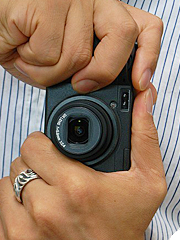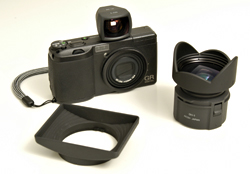Inside Story
A camera that moves people to say, “This is awesome!”
“One would expect the camera to be able to take great pictures in light conditions. We worked on polishing the specs so that a professional cameraman would say, “Wow, this is awesome, I cant believe it's a compact camera!” said Mr. Noguchi. “We have made this possible with the newly developed “GR Lens”, and also by developing the image processing to such an advanced level that it can handle the high level of performance delivered by the new lens.” “Some people are of the opinion that image processing should be performed on a PC. However, if the data that is downloaded to the PC is not high quality to start with, it is not possible to obtain high quality images through image processing. In order to achieve high quality images, the camera needs the GR Lens, from which quality images are input to the CCD, which then performs image processing to put a natural finish to the high quality images.
Despite having the experience of developing the original GR lens, when the object that collects light is a film or a CCD, the characteristics required from the lens become quite different. Large cameras can use large lenses to enable them to perform the required tasks, but as these cannot be arranged in compact digital cameras, it was clear that entirely new technology would need to be developed for this purpose. The technological development team surpassed all expectations in creating a new lens, which perfectly answers all of the compact digital camera needs, called the “GR”. Furthermore, exceptional new developments in the image processing engine field allowed us to produce the new “GR Engine”, which is able to reduce noise at the same time as obtaining high resolution images, suppresses variation in white balance and enables precise automatic exposure, enabling the expression of smooth, natural images.

The “feel” of the camera is highly important.
Additionally, we also wanted to make a camera that brought a smile to one's face, just by holding it. In order to achieve this, we had to concentrate not just on the design and operability, but also the texture and grip of the camera. “I think that this is why there are so many fans of the GR cameras”, said Mr. Higuchi. “We were aiming for a camera that feels good in your hands, that has easy to use buttons and dials, with a lingering sensation of reverberation after pressing the shutter release button. Basically, the camera should communicate a sense of comfort from the moment it is in your hands, with a continued feeling of “enjoyment” from the second you switch the power on”.
The camera's trim was designed in magnesium die-cast metal to increase both rigidity and texture, in order to realize the “camera that feels like a camera” feeling that made the GR1 so popular. One of these important features is the feel of the camera's “skin”. Mr. Noguchi added “other important concepts such as “reliability as a tool” and “comfortable operation” were also recognized as essential, and incorporated head-on in the design”.

The versatility of the camera gives it even greater appeal.
There was a great deal of debate in the planning design stage as to whether to include an optical finder. The number of people that prefer using the LCD screen to line-up and shoot pictures is increasing as the popularity of digital cameras increases. “There were a wide range of opinions on the matter”, said Mr. Higuchi. “Some people said, “we don't need a finder”, while others said, “If we are going to include one, it must be of a suitably high quality”. This is because differences between the image that the photographer sees through the finder and the actual picture taken arise through brightness, distortion, and ease of focus through the finder itself.” There was, however, a very high demand for an optical finder from fans who prefer to use the optical finder to take pictures. “We decided that instead of equipping the camera with a regular optical finder, we would design an external high performance finder for it”. The external finder has a frame size of 28mm, which converts to a 21mm frame size when the wide conversion lens is mounted. The idea of using an external finder also gives extra appeal and versatility to users who see the GR more as a tool than just a camera.
The energy and spirit of fans was also communicated to us via the Internet BLOG pages. The pages were established to gather opinions before development started, and a huge number of track-backs were attached in a short space of time. These included lots of anticipation of the “GR DIGITAL”, but also gave us a wealth of information about how people are using the GR1, what role photography plays in people's daily lives, and whole other avenues of knowledge that previous market research did not reveal. Mr. Noguchi added that “I knew there were a lot of fans out there, but I didn't realize the extent that people were anticipating the release of the GR DIGITAL, and I am truly grateful for their support”.
Additionally, the GR DIGITAL exhibition, which was held in Tokyo on September 13 and had a planned capacity of 100 GR fans, actually received 10 times that number of applications for tickets. “We hope that the 100 dedicated fans that were able to shrug off the competition and attend the Tokyo event felt a smile appear on their faces as they held the brand new GR DIGITAL cameras for the first time. I also wonder how the other fans felt as they were finally able to see the new camera first hand, when they were released on sale on October 21st”, said Mr. Noguchi. He added, “I am convinced that the development staff have all surpassed themselves, and created the best camera they could possibly make. I can't wait to hear the opinions of customers who have actually used the camera in the field, to see what their reaction is”. The technology that creates such high-resolution images and that creates such excitement among fans will be explored in more detail in the next edition of this newsletter.


